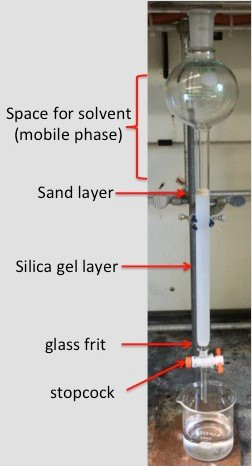Chromatographie sur colonne
Vue d'ensemble
Source : Laboratoire du Dr Jimmy Franco - Merrimack College
Chromatographie sur colonne est l’une des techniques plus utiles pour la purification de composés. Cette technique utilise une phase stationnaire, ce qui est emballée dans une colonne, et une phase mobile qui traverse la colonne. Cette technique exploite la différence de polarité entre composés, ce qui permet des molécules à séparer simpliste. 1 les deux phases stationnaires plus courantes pour chromatographie sur colonne sont le gel de silice (SiO2) et alumine (Al2O3), avec le plus couramment utilisé des phases mobiles en solvants organiques. 2 le point choisi pour la phase mobile dépendent de la polarité des molécules étant purifié. Les composés polaires plus exigent généralement des solvants polaires plus afin de faciliter le passage des molécules à travers la phase stationnaire. Une fois achevé le processus de purification le solvant peut être retiré des fractions collectées à l’aide d’un évaporateur rotatif à céder le matériel isolé.
Procédure
1. le Gel de silice lisier
- Verser le gel de silice dans un erlenmeyer. Le poids de l’emballage doit être à peu près 50 fois celui de l’échantillon étant séparé. Si les composés séparés ont des valeurs de Rf très semblables, il peut exiger à l’aide d’une grande quantité de silice par échantillon, c’est le cas dans cet exemple.
- Placer 10 g de silice dans l’erlenmeyer, étant donné que 50 mg d’échantillon (45 mg de fluorénone et 5 mg de tétraphénylporphyrine) sont être isolé.
Résultats
L’échantillon contenant un mélange de tétraphénylporphyrine (PPT, 5 mg) et de la fluorénone (45 mg) ont été séparé avec succès et chaque composé a été isolé. Le PPT élué tout d’abord la colonne comme une bande de pourpre-rougeâtre foncée et la fluorénone élué par la suite la colonne comme une bande jaune ()Figure 2). Les fractions éluées ont été recueillies dans des éprouvettes et identifiées par leurs couleurs distinctives ...
Applications et Résumé
Résumé
Chromatographie sur colonne est une méthode pratique et polyvalente pour la purification de composés. Cette méthode sépare composés basés sur la polarité. En exploitant les différences dans la polarité des molécules, chromatographie sur colonne peut séparer simpliste de composés par la vitesse à laquelle les composés traversent la phase stationnaire de la colonne. Un des avantages de la chromatographie sur colonne (surtout comparé à la recristallisatio...
References
- Mayo, D. W.; Pike, R. M.; Forbes, D. C., Microscale organic laboratory : with multistep and multiscale syntheses. 5th ed.; J. Wiley & Sons: Hoboken, NJ; p xxi, 681 p (2011).
- Armarego, W. L. F.; Chai, C. L. L., Purification of laboratory chemicals. 5th ed.; Butterworth-Heinemann: Amsterdam; Boston; p xv, 609 p (2003).
- Silverman, R. B.; Holladay, M. W., The organic chemistry of drug design and drug action. Third edition / ed.; Elsevier/AP, Academic Press, is an imprint of Elsevier: Amsterdam ; Boston; p xviii, 517 pages (2014).
- Mortensen, D. S.; Perrin-Ninkovic, S. M.; Shevlin, G.; Elsner, J.; Zhao, J.; Whitefield, B. et. al. Optimization of a Series of Triazole Containing Mammalian Target of Rapamycin (mTOR) Kinase Inhibitors and the Discovery of CC-115. Journal of Medicinal Chemistry (2015).
- Davies, D. R.; Johnson, T. M., Isolation of Three Components from Spearmint Oil: An Exercise in Column and Thin-Layer Chromatography. Journal of Chemical Education,84 (2), 318 (2007).
- Taber, D. F.; Hoerrner, R. S., Column chromatography: Isolation of caffeine. Journal of Chemical Education, 68 (1), 73 (1991).
Tags
Passer à...
Vidéos de cette collection:

Now Playing
Chromatographie sur colonne
Organic Chemistry
360.1K Vues

Introduction à la catalyse
Organic Chemistry
34.5K Vues

Montage d'un chauffage à reflux
Organic Chemistry
167.4K Vues

Réaliser des réactions en dessous de la température ambiante
Organic Chemistry
70.6K Vues

Transfert de solvants via une rampe à vide (ligne Schlenk)
Organic Chemistry
41.6K Vues

Dégazage des liquides par la technique "cycle geler-pomper-dégeler"
Organic Chemistry
56.1K Vues

Préparation de réactifs anhydres et équipement
Organic Chemistry
79.3K Vues

Purification des composés par recristallisation
Organic Chemistry
708.5K Vues

Séparation des mélanges par précipitation
Organic Chemistry
157.8K Vues

Extraction solide-liquide
Organic Chemistry
237.8K Vues

Utilisation d'un évaporateur rotatif (ou Rotovap) pour éliminer un solvant
Organic Chemistry
212.8K Vues

Distillation fractionnée
Organic Chemistry
334.3K Vues

Préparation de cristaux pour analyse par diffraction des rayons X
Organic Chemistry
32.4K Vues

Performing 1D Thin Layer Chromatography
Organic Chemistry
289.7K Vues

Spectroscopie à résonance magnétique nucléaire (RMN)
Organic Chemistry
247.8K Vues
